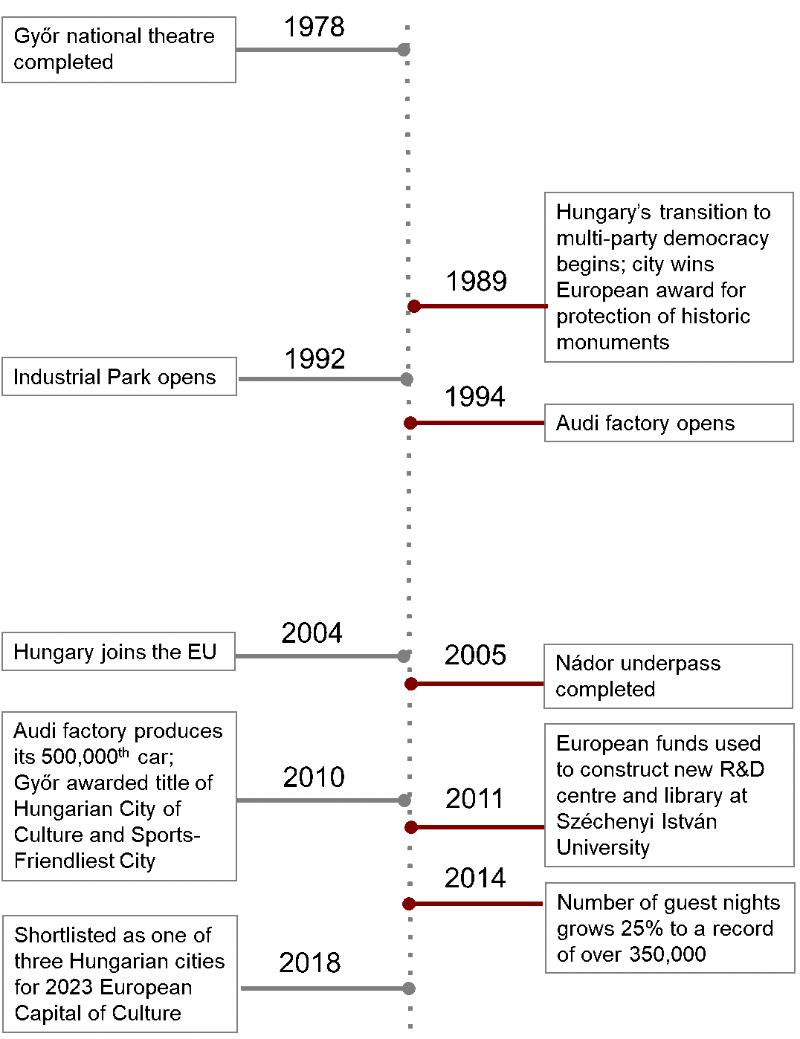By Éva Gerőházi and Iván Tosics
The findings, interpretations and conclusions are those of the authors and do not necessarily reflect the views of the European Investment Bank.
>> Download the entire essay as eBook or PDF
Situated within the Budapest-Vienna-Bratislava triangle, and at the intersection of mainland and riverine trade routes, Győr is, despite its relatively small size, arguably the most important city in Northwest Hungary. Designated as one of the seven main regional centres of the country, in the current European urban hierarchy system Győr and its surroundings are classified as a functional urban area of national and international importance. Like many other central European cities, Gyor has undergone profound changes to its urban fabric and economy over the past half-century.
Since the 1970s, Győr has grown quickly and has been targeted by foreign direct investors at a rate disproportionate to its small size. A leading factor in this economic development has been the city’s historically strong and well-developed automotive industry, but other factors, such as high rail and road accessibility and a better developed infrastructure platform than the Hungarian average, an embedded culture of equal opportunities and high standards of education and training, have also been important.
From the first third of the 1990s, when the majority of Győr’s state-owned companies were transformed into economic corporations, growth accelerated further. Two key watershed moments for the city in this period were the opening of the industrial park in 1992, which has since gone on to achieve global recognition, and the opening of an Audi subsidiary factory in 1994. Today, the industrial park is home to more than 100 companies from fourteen countries.
Győr‘s economic growth has also been reinforced by reconstruction of the city centre, which also began in the 1970s. In 1989, the city won a European award for its dedication to the protection and preservation of monuments, although it was only after the millennium that the city embarked on its biggest construction and renovation projects. Some of the most significant projects include the construction of the Nádor underpass and new multi-storey car parks to relieve downtown traffic congestion, the renovation of the inner-downtown district, including several high-profile civic squares, and the launch of a free city bus service which can be used by anyone to get anywhere in the downtown area. The renovated historic monuments and newly refurbished castle bastions have provided new authentic venues for heritage events in the city.
Economic growth, in turn, has created imperatives for a more integrated infrastructure platform for the city, and it is here that the role of the EIB can be most clearly seen. As the city has grown, the EIB has helped finance new rolling stock for the city’s rail connections in an effort to provide higher quality rail services on the Austrian-Hungarian cross-border rail network. It has also assisted in the upgrade and extension of the city’s electricity transmission network, integrating the greater urban area of Budapest with the northwest of the country. In recent years, European funds have funded a new research and development centre and library at one of the city’s major universities.
Today, Győr outperforms the national average on many measures of economic success. The city’s GDP per capita is 12% higher than the national average, and residential house prices are increasing at a rate of 10% year-on-year. Future plans highlight the city’s intentions to continue developing its infrastructure platform, but also to branch out into culture and to consolidate its emerging reputation as a sports city. An inner-bypass ring road is forecast to begin construction in 2019, while the city and regional bus terminal and rail station are to be renovated and integrated. This will help ensure that Győr continues to contribute to Hungary’s economic growth.
Meanwhile, the site of a more-than-100-years-old factory close to the historical downtown and the river is to be replaced by a new master-planned community. This is an effort to position the city as a counterpoint to the opportunities offered by nearby Vienna and Budapest. The city has recently been shortlisted as one of the contenders for the 2023 European Capital of Culture. The ultimate goal for the city, as outlined by the mayor, is to grow to a city of 300,000, in which tourism, culture and education combine to ensure a liveable environment for all.
The findings, interpretations and conclusions are those of the authors and do not necessarily reflect the views of the European Investment Bank.
